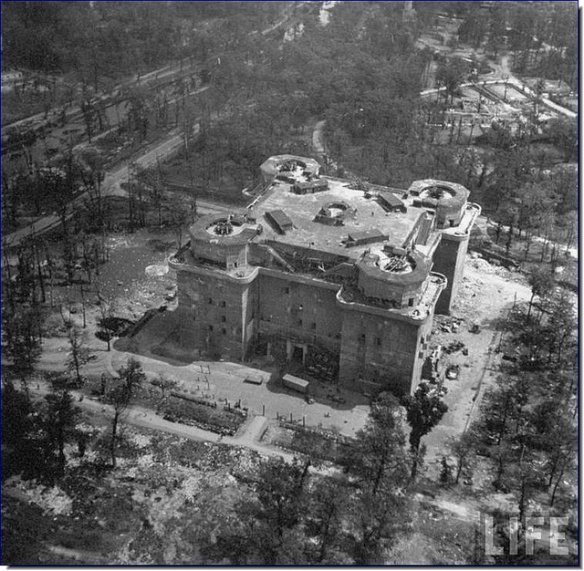The Zoo flak tower
Berliners had been repeatedly told that theirs was the best-defended city in the world. And, for once, Nazi propagandists were telling the unglossed truth: Berlin’s air defences really were state-of-the-art.
The centrepiece of the hugely impressive network of defences in the city was the three Berlin flak towers. The first of these concrete behemoths appeared on the capital’s skyline in April 1941, in the heart of the Zoo, to the west of the city centre. It rose some 39 metres into the sky – taller than the nearby railway station at Bahnhof Zoo, taller even than the tallest trees in the nearby Tiergarten. In the rather flat, low-rise landscape of Berlin, it would have been hard to miss.
Broadly square in plan, the tower’s side walls – over 3 metres thick and over 70 metres across – were rendered in raw concrete and studded with small windows. Resembling a huge medieval fortress, it was adorned at each corner with a squat, octagonal tower, and beneath the roof were five floors of storage rooms and air raid shelters, even a hospital ward. Designed to accommodate eight thousand civilians, it also provided an air-conditioned home to many of the valuables from Berlin’s museums, including the golden treasures of Priam and the bust of Nefertiti.
The building’s sheer size was not only the result of the Nazis’ passion for monumental architecture. It was in essence an enormous static gun platform – and it fairly bristled with weaponry. At each of its four corners, there was a heavy-calibre anti-aircraft gun. The 128mm ‘Dora’ flak gun was one of the largest produced during the war, and weighing in at over 25 tonnes – with a further 25-tonne recoil force – it required a substantial structure to support it. In addition, guns of lesser calibres, such as the 20mm Vierling, or four-barrelled ‘quad’ weapon, were located elsewhere on the roof.
Apart from the Zoo flak tower, two identical towers were erected to form an arc around the centre of Berlin, one at Humboldthain to the north and the other at Friedrichshain to the east. Each flak tower – known as the G-Turm, or ‘battery tower’ – was accompanied by a nearby L-Turm, or ‘command tower’, which was of a similar size and equipped with searchlights, listening equipment and radar installations.
The flak towers were meant to intimidate Germany’s enemies, but they also served to convince Berliners that they could be protected from the RAF. They certainly made an impression on the American journalist Howard Smith. The Zoo tower, he wrote,
looks like a fantastic monstrosity from a lost world, or another planet. It is huge and positively frightening just to look at. . . . It is an enormous, square clod of cement a hundred feet high, about five or six storeys. It is painted green so as not to be too visible among the trees from above. On each of its corners is a long, powerful gun, pointed at the sky.
Living nearby, Missie Vassiltchikov noted the new addition to the skyline in her diary in April 1941: ‘Our flat is very near the Zoo bunker’, she wrote, ‘which has just been built of heavy concrete. It is very high and sprouting with flak guns, and is considered the safest air-raid shelter in this part of the town. When the guns start firing the earth trembles, and even in our flat the noise is ear-splitting.’
Despite their size and grim grandeur, the flak towers were only the most visible part of an enormous and highly sophisticated ring of defences around the German capital. Since 1940 Berlin’s air defences had been systematically upgraded, with a central command centre, located within the Zoo tower. They were remarkably complex, consisting of two primary rings of defences surrounding the city – an outer searchlight ring approximately 50 kilometres from the city centre and an inner flak ring around 30 kilometres out. Interspersed between them were smoke generators, which could send a pall of thick, grey smoke many miles across the city, obscuring large parts of it from view. Within Berlin itself, many main streets, boulevards and military installations were strung with camouflage netting, so as to make them difficult to identify from the air. This tactic was also applied to some of the city’s waterways, which could otherwise serve as a vital point of reference for enemy pilots. The Lietzen Lake in Charlottenburg, for instance, was disguised to make it look like a suburban landscape.
